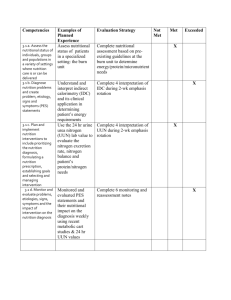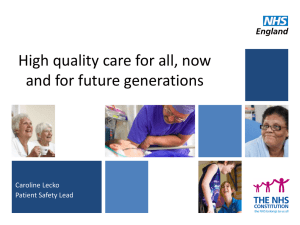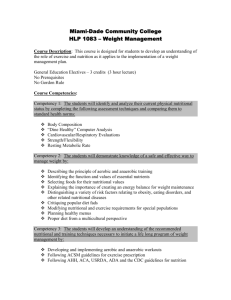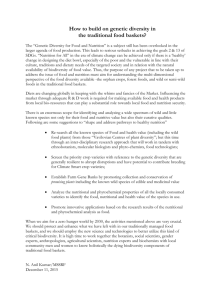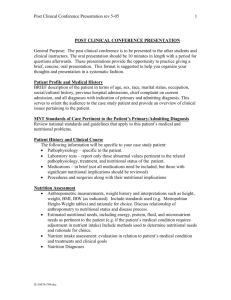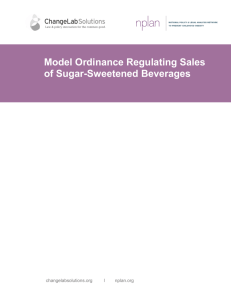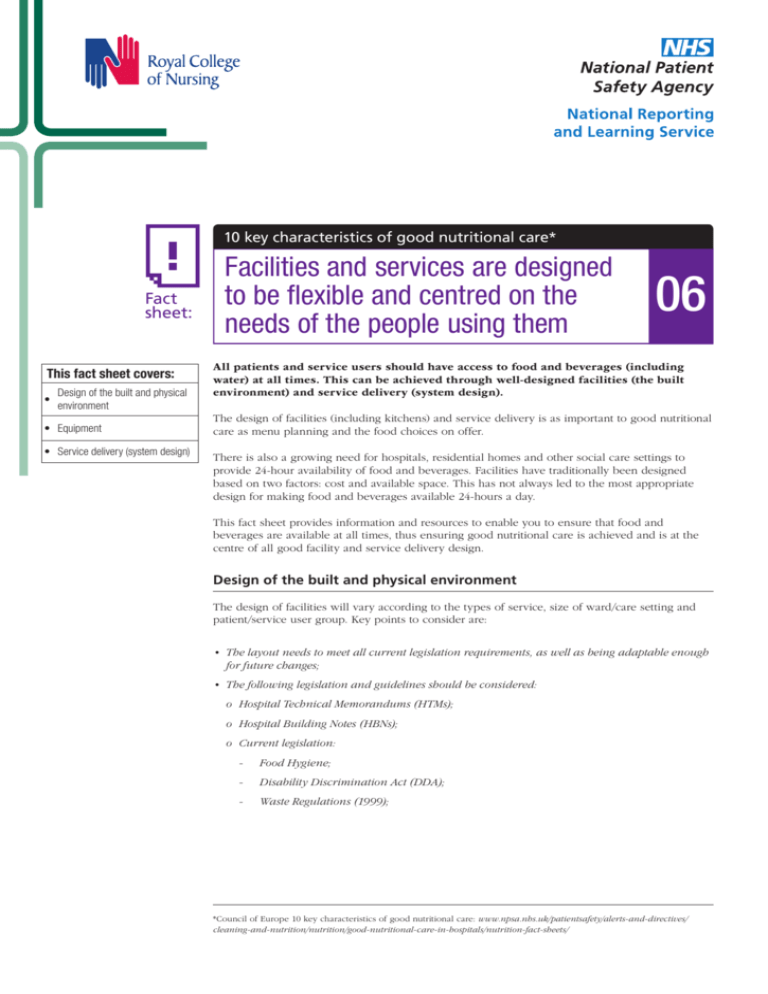
10 key characteristics of good nutritional care*
Fact
sheet:
This fact sheet covers:
•
Design of the built and physical
environment
• Equipment
• Service delivery (system design)
Facilities and services are designed
to be flexible and centred on the
needs of the people using them
06
02
All patients and service users should have access to food and beverages (including
water) at all times. This can be achieved through well-designed facilities (the built
environment) and service delivery (system design).
The design of facilities (including kitchens) and service delivery is as important to good nutritional
care as menu planning and the food choices on offer.
There is also a growing need for hospitals, residential homes and other social care settings to
provide 24-hour availability of food and beverages. Facilities have traditionally been designed
based on two factors: cost and available space. This has not always led to the most appropriate
design for making food and beverages available 24-hours a day.
This fact sheet provides information and resources to enable you to ensure that food and
beverages are available at all times, thus ensuring good nutritional care is achieved and is at the
centre of all good facility and service delivery design.
Design of the built and physical environment
The design of facilities will vary according to the types of service, size of ward/care setting and
patient/service user group. Key points to consider are:
• Thelayoutneedstomeetallcurrentlegislationrequirements,aswellasbeingadaptableenough
for future changes;
• Thefollowinglegislationandguidelinesshouldbeconsidered:
o HospitalTechnicalMemorandums(HTMs);
o Hospital Building Notes (HBNs);
o Current legislation:
-
Food Hygiene;
-
DisabilityDiscriminationAct(DDA);
-
WasteRegulations(1999);
*Council of Europe 10 key characteristics of good nutritional care: www.npsa.nhs.uk/patientsafety/alerts-and-directives/
cleaning-and-nutrition/nutrition/good-nutritional-care-in-hospitals/nutrition-fact-sheets/
• The design should allow for food service on a 24-hour/
7-day basis (where applicable). This can be provided through a
number of food service systems, namely:
o Traditional kitchens;
o B
everage bays/pantries/small unit kitchens – allowing for
beverages and snacks, e.g. cakes, fruit, yoghurts, toast, to
be served when required. They can also allow residents
similar access and can be set up as a small dining area –
particularly important when encouraging residents with
conditions such as dementia to eat;
o W
ard kitchens – allows for the provision of light bites, e.g.
jacket potatoes, toast and omelettes;
• It is important that all professions work together on any
designs (see nutrition fact sheet 3);
• Design should allow for easy access to food/beverages
(including water) for all service users/patients (where
applicable);
• Consideration should be given to dining areas where
communal eating and drinking can take place as this is
known to aid food intake;
• The built environment is very much dependent on the
method of service delivery, be this fresh cook, frozen
regenerated, cook chill etc;
Service delivery (system design)
The government is promoting 24-hour accessible food and
beverage provision through Essence of Care and the Patient
Environment Action Team (PEAT), and it is promoted through
local authorities via a more person-centred approach, giving
service users greater choice through, for example, direct
payments. Traditional service delivery will need to be reviewed
and adapted to support these changes.
Information about facilities, food, beverage and nutrition options
must be accessible to all service users/patients and carers. The
information should be available in a wide range of formats,
including appropriate languages, via the internet, and in
written form.
Systems should be designed to ensure that patients and service
users are able to enjoy and eat their meals in an environment
that is conducive to eating (Protected Mealtimes; see nutrition
fact sheet 2).
Any new service delivery system should have the safety of
patients and service users at its core (see nutrition fact sheet 1).
Resources
• Use the Hydration Toolkit for Hospitals or the Hydration Toolkit
for Care Homes;
Hospital Caterers Association. Good Practice Guide Healthcare Food and
Beverages Service Standards: A guide to ward level services. 2006. Available at:
www.hospitalcaterers.org/publications
• Consideration should be given to the Council of Europe
Resolution.
Hospital Caterers Association. Retail and Commercial Service Standards: An
operational guide to services. 2008.
The above is not an exhaustive list and it is recommended
that advice is sought from Estates/builders or the appropriate
department within your organisation.
Equipment
Choosing the right equipment is just as critical as the design
in meeting the needs of a 24-hour food and beverage service.
Some of the aspects that should be considered are:
• Storage;
• Refrigeration and freezing;
Hydration Best Practice Toolkit for Hospitals and Healthcare. www.rcn.org.uk/
nutritionnow
Hydration Best Practice Toolkit for Care Homes. www.waterforhealth.org.uk
Department of Health. The Essence of Care: Patient-focused benchmarks
for Clinical Governance. 2001. www.dh.gov.uk/en/Publicationsandstatistics/
Publications/PublicationsPolicyAndGuidance/DH_4005475
Patient Environment Action Team. www.npsa.nhs.uk/patientsafety/
improvingpatientsafety/cleaning-and-nutrition/peat/
Council of Europe Resolution ResAP (2003)3 on food and nutritional care in
hospitals. www.hospitalcaterers.org/documents/cu.pdf
The British Dietetic Association. Delivering Nutrition Care Through Food and
Beverage Services. 2006. Available at: www.bda.uk.com/resources/Delivering_
Nutritional_Care_through_Food_Beverage_Services.pdf
• Microwaves;
• Toasters;
• Hobs;
• Waste bins.
BMA
BAPEN
Supporting the thrust of
the 10 characteristics
Advancing Clinical Nutrition
The NPSA would like to thank Sodexo, ISS Mediclean, Interserve and Medirest for contributing their time and expertise to the production of this fact sheet. © National Patient Safety Agency 2008. Copyright and other intellectual property
rights in this material belong to the NPSA and all rights are reserved. The NPSA authorises healthcare organisations to reproduce this material for educational and non-commercial use.
Ref: 0735 September 2008




